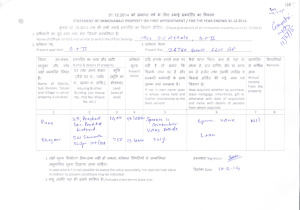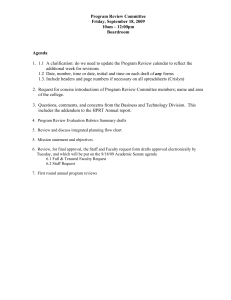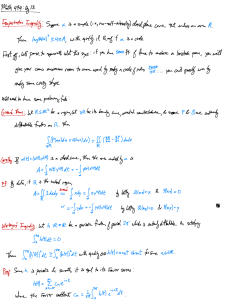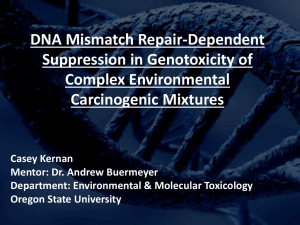Presented by: Sarah Ferrer and Molecular Toxicology Department
advertisement
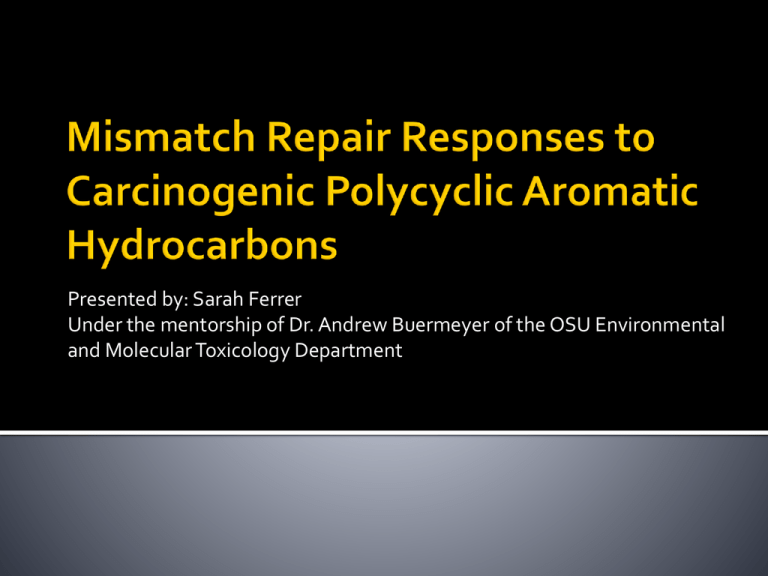
Presented by: Sarah Ferrer Under the mentorship of Dr. Andrew Buermeyer of the OSU Environmental and Molecular Toxicology Department MMR deficiency linked to colorectal (and other) cancer predisposition. Lynch Syndrome causes premature cancer occurrence and greater reoccurrence. MMR protects against DNA mutations. PAHs are carcinogens found in the environment. Metabolized by the liver and colon into diol epoxides. PAHs used in my research project: Benzo-[a]-pyrene Benzo-[c]-phenanthrene MMR proteins can bind to and recognize PAH adducted DNA MMR proficient cells are more effective at maintaining DNA integrity in human lymphoblastic cell lines than MMR deficient cells when exposed to PAHs benzo-[a]-pyrene and benzo-[c]-phenanthrene. Human lymphoblastoid cell lines TK6 and MT1 Maintained under the following conditions: 10% complete RPMI media Incubated with 5% carbon dioxide and at 38°C Cell density between 5 x 104 cells/mL and 1 x 106 cells/mL Growth curves created over several dilutions and compared to the characterized doubling times. TK6 Growth Curves (8/3-8/7) MT1 (8/7-8/11) MT1Growth GrowthCurves Curves(8/7-8/11) (8/3-8/7) 10 10 10 cells/ml) (*10^6cells/ml) Conc. (*10^6 Conc. cells/ml) (*10^6 Conc. cells/ml) (*10^6 Conc. 1 11 0 00 0 20 20 20 20 40 40 40 40 60 60 80 80 60 60 0.1 0.1 0.1 0.1 0.01 0.01 0.01 0.01 0.001 Hours from beginning Hours from beginning Hours beginning Hours from from beginning 100 100 80 80 120 120 100 100 0.2*10^6 A=0.2*10^6 0.2*10^6 A=0.2*10^6 B=0.1*10^6 0.1*10^6 0.1*10^6 B=0.1*10^6 C=0.05*10^6 0.05*10^6 C=0.05*10^6 0.05*10^6 D=0.01*10^6 0.01*10^6 D=0.01*10^6 0.01*10^6 Percentage Percentage of Wells of Wells withwith Visable HPRT Colonies Mutants (Plating Hypoxanthine guanine phosphoribosyl Percentage of Wells with HPRT Mutants Present Before HAT Efficiency) transferase (HPRT) reporter gene. 100% 100% 100% 90% 90% 99% 80% 80% Percent Percent 60% 97% 60% 50% 50% 40% 40% 30% 30% 20% Culture with 12 million cells 70% RPMI w/ HAT media 96% Percent 70% 98% 95% not present Cells Mutants Mutants not present 94% Cells Mutants present present Mutants 93% Normal RPMI media 92% 20% 6-TG exposed 91% plate 10% 10% 90% 0% 0% MT1 MT1 (no HAT) MTI efficiency plate Plating Tk6 Cell Line MT1 (HAT) TK6 (no HAT) Cell Line Cell Line and Media Type TK6 TK6 (HAT) Re-run previous experiment to determine MF. Pick 6-TG resistant colonies and analyze for types of mutations. Normal HPRT+ cell Cell with HPRT- DNA, but HPRT+ proteins Cell with HPRTDNA and proteins When exposed to benzo-[a]-pyrene and benzo[c]-phenanthrene, MMR deficient cells lines exhibit a higher mutant frequency in the HPRT gene than MMR proficient cells. Dr. Andrew Buermeyer Vidya Schalk Kevin Ahern Howard Hughes Medical Institute
